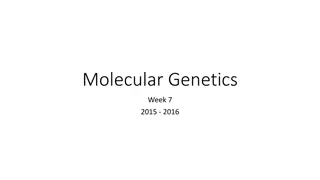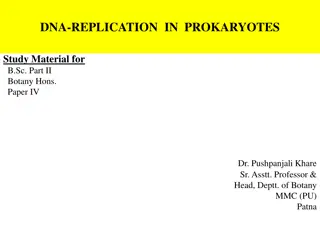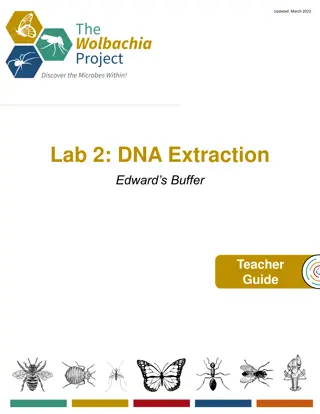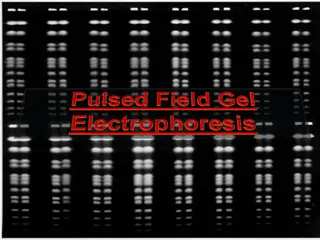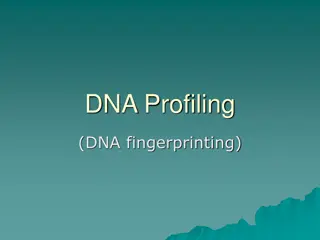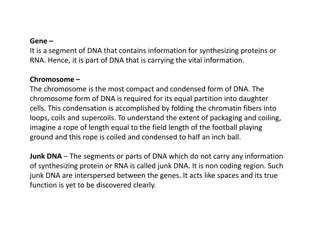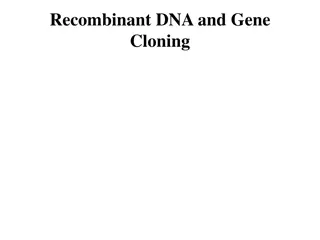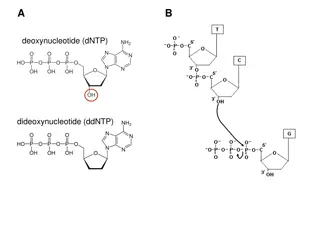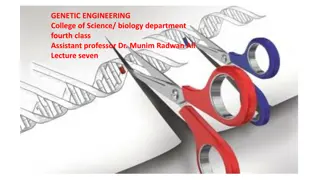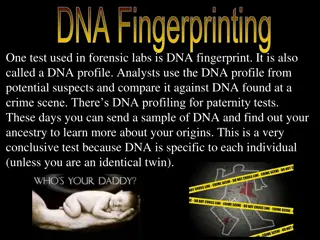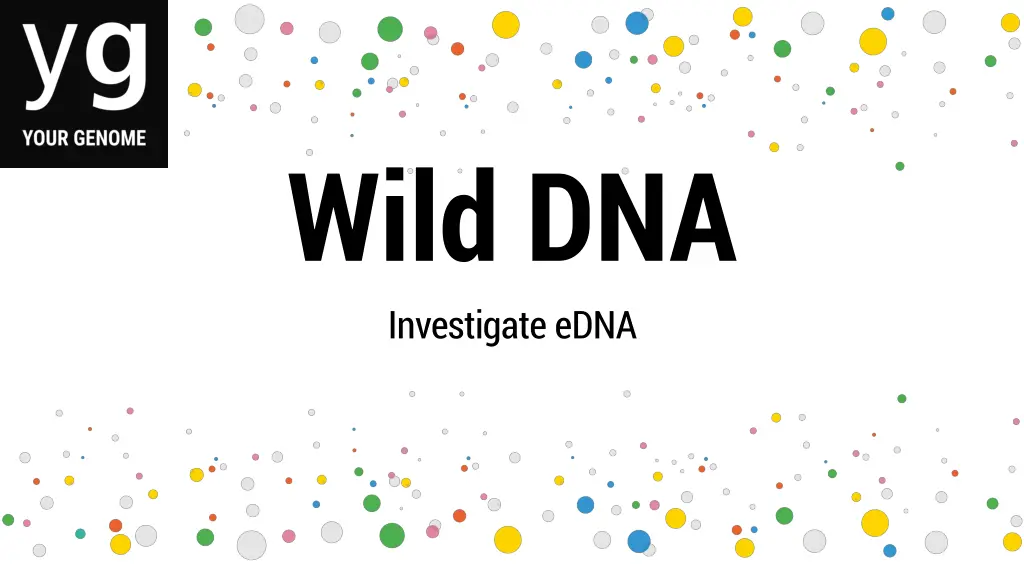
Unveiling the World of eDNA
Explore the realm of environmental DNA (eDNA) - DNA remnants left by organisms in their surroundings. Learn about eDNA collection, applications in species detection, population studies, climate change impact analysis, disease monitoring, and ecosystem health assessment.
Download Presentation

Please find below an Image/Link to download the presentation.
The content on the website is provided AS IS for your information and personal use only. It may not be sold, licensed, or shared on other websites without obtaining consent from the author. If you encounter any issues during the download, it is possible that the publisher has removed the file from their server.
You are allowed to download the files provided on this website for personal or commercial use, subject to the condition that they are used lawfully. All files are the property of their respective owners.
The content on the website is provided AS IS for your information and personal use only. It may not be sold, licensed, or shared on other websites without obtaining consent from the author.
E N D
Presentation Transcript
Wild DNA Investigate eDNA
DNA function DNA is the long molecule that contains the instructions for an organism These instructions give the information needed for an organism to develop, grow and function Different organisms have different instructions in their DNA The instructions for an organism are found in their DNA sequence yourgenome.org
DNA sequence DNA sequences are a series of letters (A, C, G and T), which represent bases in the DNA ATTCGCGTATTAGCGCGATAGCTCTGCGCTATATAGCGGCGATATATATGAT GTGAGTCGTGCTGATGCGTGAGTCGTAGTGCTGCGATGCTGTCGATTAGTCG CTGTCGATGATGAGAGACGATAGCAGATACTACGACATCAGCATCAGACATC The DNA sequence is unique to an organism, so we can use it to identify which organism a DNA sample comes from ATTCGCGTATTAGCGCGATAGCTC TGCGCTATATAGCGGCGATATATA TGATGTGAGTCGTGCTGATGCGTG ATTCGGCTATTAGCGCGATAGCTC TCCGCTATATAGCGGCGATATATA TGATGTGAGTCGTGCTGATGTTTG yourgenome.org
DNA location DNA is found in the nucleus of cells from eukaryotic species When cells are replaced, old cells can be left behind in the environment This means the DNA in these cells will also be left behind in the environment Animal cell yourgenome.org Image credit: Laura Olivares Bold / Wellcome Connecting Science
What is eDNA? eDNA stands for: environmental DNA It is DNA left by an organism in an environment eDNA could be found in old cells left behind in: faeces external cells shed by an organism (e.g. skin cells) bodily fluids (e.g. blood or urine) eDNA can be collected from the environment yourgenome.org Image credit: Albert Herring Image credit: Andr K nzelmann Image credit: Adam Rash
What can eDNA be used for? Current research is using eDNA to: detect species in an area determine approximate population density in an area study the impact of climate change monitor for diseases assess overall health of an ecosystem For example, eDNA can be used to estimate population density of commonly fished species, using water samples from fishing locations. This can indicate if an area is at risk of over-fishing. Image credit: Joachim Mullerchen yourgenome.org
DNA sampling eDNA can be obtained from: blood excrement saliva soil leaves water samples Image credit: phloxii Image credit: Freepik Image credit: Andr K nzelmann Image credit: PhotographyFirm Image credit: W.carter yourgenome.org
How does eDNA sampling work? Sequence DNA Analyse data Collect sample Extract DNA in a lab Samples are collected from different locations in a wetland area and sent to the lab eDNA is extracted, processed and sent for DNA sequencing Bioinformatics is used to compare the DNA found to an online DNA database, allowing identification of the species present in the area yourgenome.org
The benefits of identifying species All species in an ecosystem will have an impact through: their habitat competition for resources position in the food web By identifying species using eDNA, not only do we know about the organisms found in an ecosystem, but we can consider their impact and the effect of changes on them. yourgenome.org
The benefits of identifying species For example: Predatorpopulations, if unchecked, can drastically reduce populations of prey. Image credit: Education images / Universal Images Group Editorial Endangered species in an ecosystem may require additional measures for protection, such as maintaining water quality in their habitat. Image credit: Peter Trimming Invasive species introduced into an area will not have evolved with predators and may bring new diseases factors which can lead to them outcompeting similar native species in the ecosystem. Image credit: Chuck Homler yourgenome.org
The benefits of identifying species For example: Some species act as indicators for the health of an ecosystem, like water quality, and humans can actively maintain the environment to support their populations. Image credit: Thom Quine Image credit: Ian Alexander Image credit: Richard Bartz yourgenome.org
Wild DNA challenge Your company has been asked to carry out an ecological survey of a wetlands area and river system. Working in groups, you need to: 1. Identify the species living in your location using bioinformatics to compare eDNA sequences to an online DNA database 2. Consider the impact of these organisms on the ecosystem Image credit: Wellcome Connecting Science yourgenome.org
Wild DNA challenge Step 1: Open the Site data file document for your location on your computer. yourgenome.org
Wild DNA challenge Step 2: Go to https://blast.ncbi.nlm.nih.gov Step 3: Click Nucleotide BLAST . yourgenome.org
Wild DNA challenge Step 4: Copy your DNA sequence and paste into the Enter Query Sequence Box . yourgenome.org
Wild DNA challenge Step 5: Click BLAST at the bottom of the page to search the DNA database for a matching sequence. yourgenome.org
Wild DNA challenge Step 6: On the results page, scroll down to Sequences producing significant alignments . This will show a description of the sample your eDNA matches and the scientific name of the species. Scientific name of species Description of sample yourgenome.org
Wild DNA challenge Step 7: Once you have identified a species present at your site, use the River species list document to find out: its common name facts about it its conservation status yourgenome.org
Wild DNA challenge Step 8: Put a tick on your Site report sheet to record the presence of the species. yourgenome.org
Wild DNA challenge Step 9: Repeat steps 3-8 to identify which species each DNA sequence comes from, and to complete the table on your Site report sheet. Step 10: Consider the impact each species at your site may have on the ecosystem. Find out more about each species using the River species list Which are predators? Are there any endangered species present? Are there any invasive species present? Are any species indicators of good water quality? yourgenome.org
Wild DNA challenge Step 11: Record your findings on the second side of your Site report sheet. yourgenome.org
Wild DNA Answers
Site 1 species in the ecosystem 1. European otter 2. Grey heron 3. Common moorhen 4. Mallard duck 5. Common frog 6. Common minnow 7. Common roach 8. North American signal crayfish 9. Common darter Image credit: Bernard Landgraf Image credit: Laitche Image credit: Alexis Lours Image credit: Richard Bartz Image credit: Richard Bartz Image credit: Cl ment Bardot yourgenome.org Image credit: Karelj Image credit: Astacoides Image credit: L B Tettenborn
Site 1 impact on the ecosystem Which of these species are predators? European otter, grey heron, North American signal crayfish Are there any endangered species present? None at this location Are there any invasive species? North American signal crayfish: Burrow into riverbanks, damaging structure and vegetation. Outcompeted and infected native white-clawed crayfish with fungal disease. Are any species indicators of good water quality? None at this location yourgenome.org
Site 2 species in the ecosystem 1. European water vole 2. Common kingfisher 3. Mallard duck 4. Common frog 5. Common minnow 6. Common roach 7. Emperor dragonfly 8. Common mayfly 9. Blue tailed damselfly Image credit: Peter Trimming Image credit: Andreas Trepte Image credit: Richard Bartz Image credit: Richard Bartz Image credit: Cl ment Bardot Image credit: Karelj yourgenome.org Image credit: Quartl Image credit: Zapyon Image credit: Charles J Sharp
Site 2 impact on the ecosystem Which of these species are predators? Common kingfisher Are there any endangered species present? Water vole Are there any invasive species? None at this location Are any species indicators of good water quality? Common mayfly: Sensitive to pollution, their presence is a strong indicator of good water quality as they require oxygen-rich water to lay their eggs and for nymphs to develop. yourgenome.org
Site 3 species in the ecosystem 1. Brown rat 2. American mink 3. Grey heron 4. Common moorhen 5. Mallard duck 6. Mute swan 7. Common roach 8. North American signal crayfish 9. Common darter Image credit: Zeynel Cebeci Image credit: Chuck Homler Image credit: Laitche Image credit: Alexis Lours Image credit: Richard Bartz Image credit: Yerpo yourgenome.org Image credit: Karelj Image credit: Astacoides Image credit: L B Tettenborn
Site 3 impact on the ecosystem Which of these species are predators? American mink, grey heron Are there any endangered species present? None at this location Are there any invasive species? Brown rat: Outcompeted native black rat, causing their numbers to decline. Can spread disease, impacting native wildlife. American mink: Species linked to the decline in water vole populations. North American signal crayfish: Burrow into riverbanks, damaging structure and vegetation. Outcompeted and infected native white-clawed crayfish with fungal disease. Are any species indicators of good water quality? None at this location yourgenome.org
Site 4 species in the ecosystem 1. European otter 2. Mallard duck 3. Common frog 4. European eel 5. Northern pike 6. European perch 7. Common roach 8. Water spider 9. Emperor dragonfly Image credit: Bernard Landgraf Image credit: Richard Bartz Image credit: Richard Bartz Image credit: GerardM Image credit: Jik jik Image credit: Canal River Trust yourgenome.org Image credit: Karelj Image credit: Baupi Image credit: Quartl
Site 4 impact on the ecosystem Which of these species are predators? European otter, Northern pike, European perch, water spider Are there any endangered species present? European eel Are there any invasive species? None at this location Are any species indicators of good water quality? None at this location yourgenome.org
Summary Old cells are left by an organism in the environment These old cells still contain DNA and can be collected in eDNA (environmental DNA) samples DNA can be extracted from eDNA samples and sequenced Using bioinformatics, DNA sequences can be compared to an online database to identify the species present Finding the species present in the environment using DNA allows us to study the biodiversity in an area Knowing about the biodiversity in an area can help us find endangered species, invasive species and learn more about water quality yourgenome.org
Wild DNA Investigate eDNA


